

Compact Muon Solenoid
LHC, CERN
| CMS-SUS-15-009 ; CERN-EP-2017-124 | ||
| Search for natural supersymmetry in events with top quark pairs and photons in pp collisions at $\sqrt{s} = $ 8 TeV | ||
| CMS Collaboration | ||
| 10 July 2017 | ||
| JHEP 03 (2018) 167 | ||
| Abstract: Results are presented from a search for natural gauge-mediated supersymmetry (SUSY) in a scenario in which the top squark is the lightest squark, the next-to-lightest SUSY particle is a bino-like neutralino, and the lightest SUSY particle is the gravitino. The strong production of top squark pairs can produce events with pairs of top quarks and neutralinos, with each bino-like neutralino decaying to a photon and a gravitino. The search is performed using a sample of pp collision data accumulated by the CMS experiment at $\sqrt{s} = $ 8 TeV, corresponding to an integrated luminosity of 19.7 fb$^{-1}$. The final state consists of a lepton (electron or muon), jets, and one or two photons. The imbalance in transverse momentum in the events is compared with the expected spectrum from standard model processes. No excess event yield is observed beyond the expected background, and the result is interpreted in the context of a general model of gauge-mediated SUSY breaking that leads to exclusion of top squark masses below 650-730 GeV. | ||
| Links: e-print arXiv:1707.03325 [hep-ex] (PDF) ; CDS record ; inSPIRE record ; CADI line (restricted) ; | ||
| Figures | |
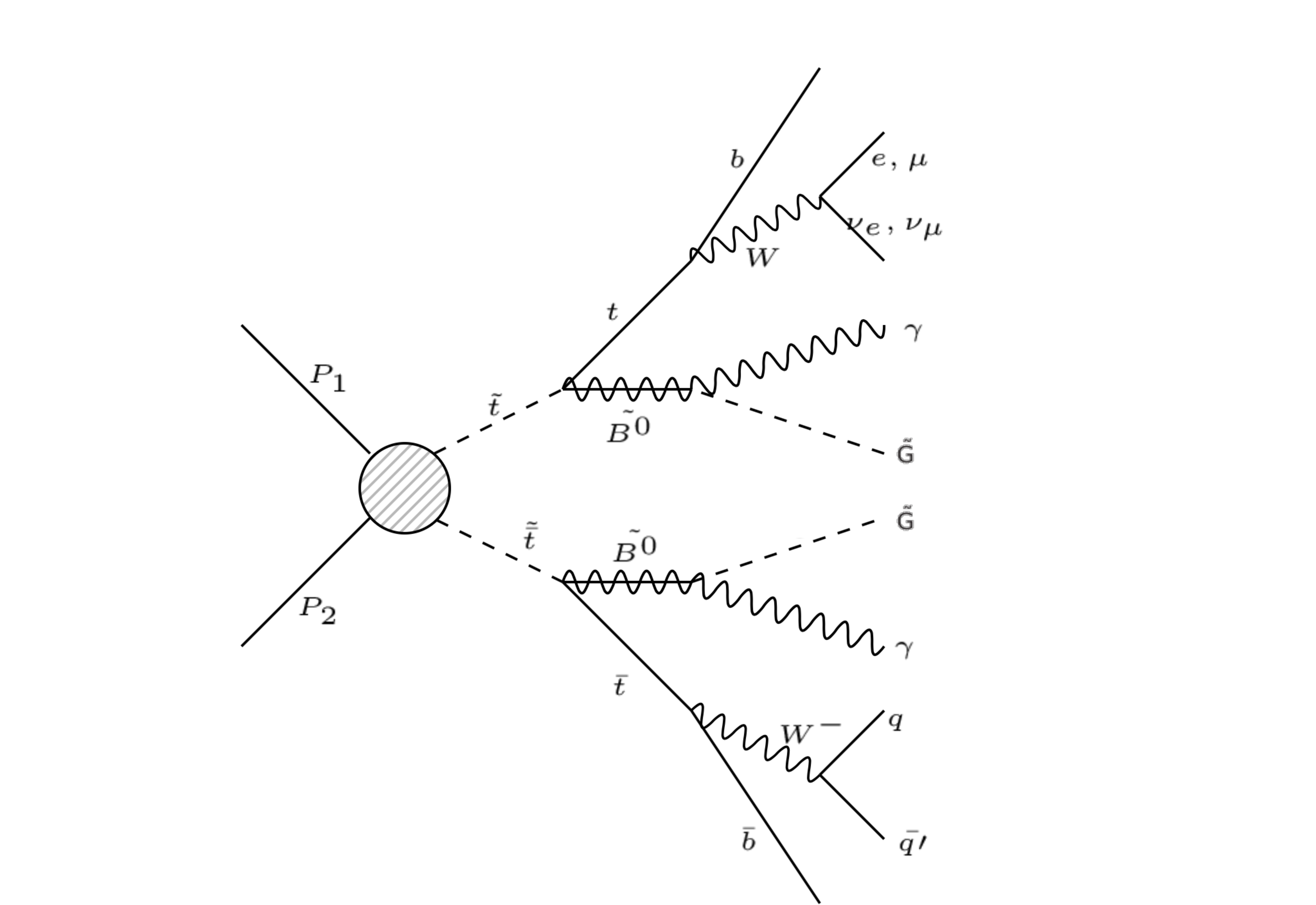
png pdf |
Figure 1:
The event topology used to search for low mass top squarks pairs |

png pdf |
Figure 2:
The dilepton invariant masses used in determining $SF_{{\mathrm {Z}} (\gamma)}$ (upper pane) for the electron and (middle pane) for the muon channels. The lower pane shows the result of the fit of $m_{{\mathrm {e}} {\gamma}}$ SR1 electron data (without the b tag requirement) to determine $SF_{{\mathrm {e}}\to \gamma}$. The mass spectra are shown post-fit after the application of the derived scale factors. The ratio of data to the total background is included in the lower panel of each plot. Uncertainties include the quadratic sum of all statistical and systematic components. |
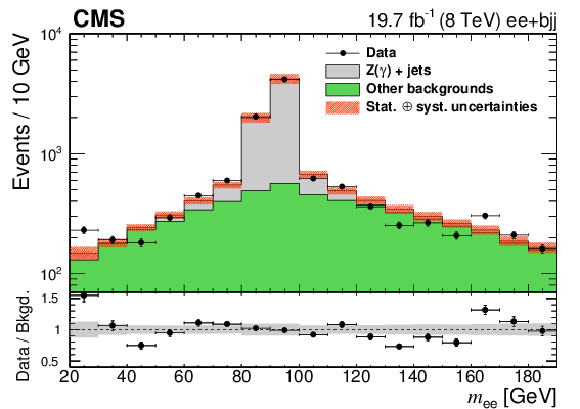
png pdf |
Figure 2-a:
The dielectron invariant masses used in determining $SF_{{\mathrm {Z}} (\gamma)}$ (upper pane) for the electron and (middle pane) for the muon channels. |
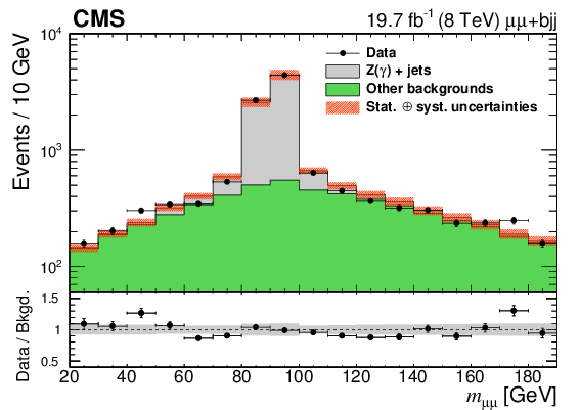
png pdf |
Figure 2-b:
The dimuon invariant masses used in determining $SF_{{\mathrm {Z}} (\gamma)}$ (upper pane) for the electron and (middle pane) for the muon channels. |
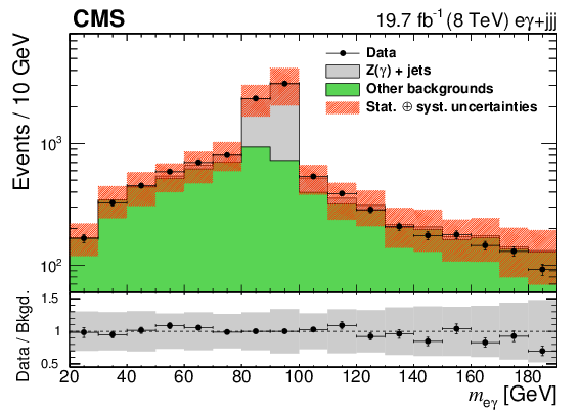
png pdf |
Figure 2-c:
Result of the fit of $m_{{\mathrm {e}} {\gamma}}$ SR1 electron data (without the b tag requirement) to determine $SF_{{\mathrm {e}}\to \gamma}$. The mass spectra are shown post-fit after the application of the derived scale factors. The ratio of data to the total background is included in the lower panel. Uncertainties include the quadratic sum of all statistical and systematic components. |

png pdf |
Figure 3:
Comparison of data and simulated events as a function of $ {{p_{\mathrm {T}}} ^\text {miss}} $ for the combined e and $\mu $ control regions is shown: (upper pane) CR1 with one fake photon, and (lower pane) CR2 with two fake photons. The content of each bin is normalized to its bin width. The ratios of data to background are shown below the two panels. The overall uncertainties are obtained from the sum in quadrature of the statistical and systematic components. Note the Diboson background includes WW, WZ, ZZ, W+gamma, and Z+gamma. |

png pdf |
Figure 3-a:
Comparison of data and simulated events as a function of $ {{p_{\mathrm {T}}} ^\text {miss}} $ for the combined e and $\mu $ for the CR1 control region with one fake photon. The content of each bin is normalized to its bin width. The ratio of data to background is shown below. The overall uncertainties are obtained from the sum in quadrature of the statistical and systematic components. Note the Diboson background includes WW, WZ, ZZ, W+gamma, and Z+gamma. |
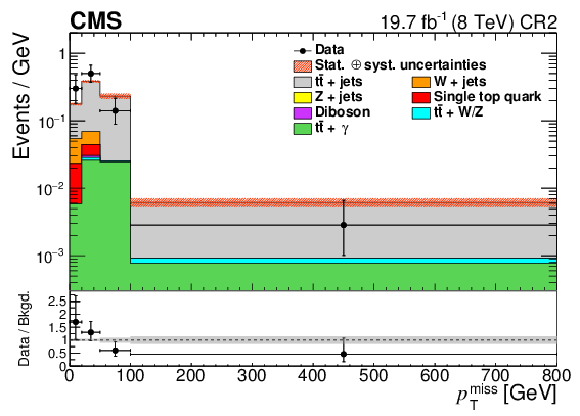
png pdf |
Figure 3-b:
Comparison of data and simulated events as a function of $ {{p_{\mathrm {T}}} ^\text {miss}} $ for the combined e and $\mu $ for the CR2 control region with two fake photons. The content of each bin is normalized to its bin width. The ratio of data to background is shown below. The overall uncertainties are obtained from the sum in quadrature of the statistical and systematic components. Note the Diboson background includes WW, WZ, ZZ, W+gamma, and Z+gamma. |
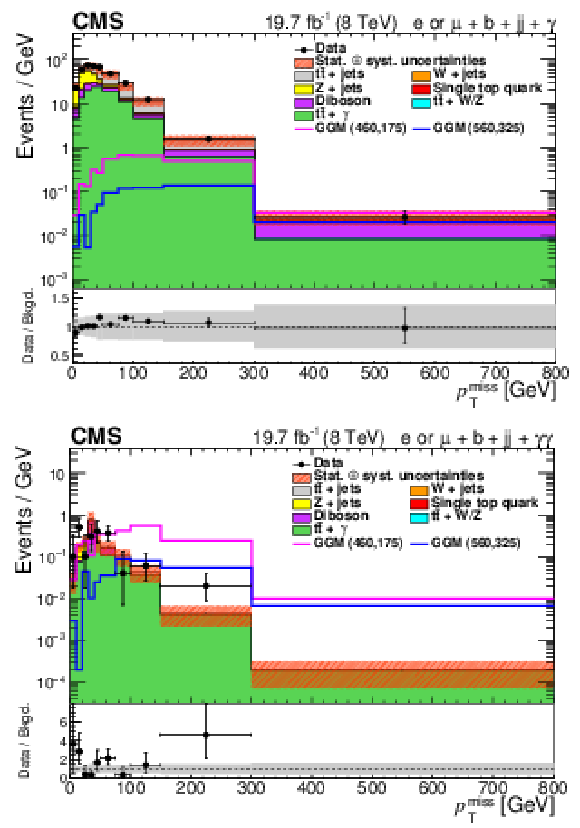
png pdf |
Figure 4:
Comparison of data and MC simulation in $ {{p_{\mathrm {T}}} ^\text {miss}} $ for the combined (e and $\mu $) signal regions: (upper pane) SR1 with one reconstructed photon and (lower pane) SR2 with two reconstructed photons. Each bin is normalized by its bin width. |
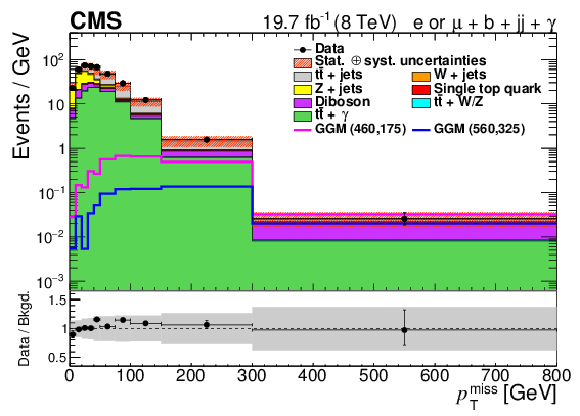
png pdf |
Figure 4-a:
Comparison of data and MC simulation in $ {{p_{\mathrm {T}}} ^\text {miss}} $ for the combined (e and $\mu $) SR1 signal region with one reconstructed photon. Each bin is normalized by its bin width. |
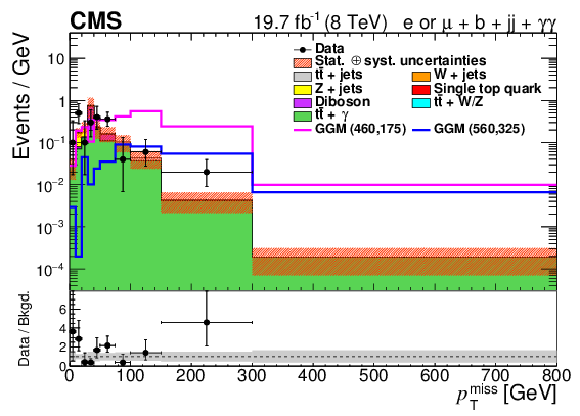
png pdf |
Figure 4-b:
Comparison of data and MC simulation in $ {{p_{\mathrm {T}}} ^\text {miss}} $ for the combined (e and $\mu $) SR2 signal region with two reconstructed photons. Each bin is normalized by its bin width. |
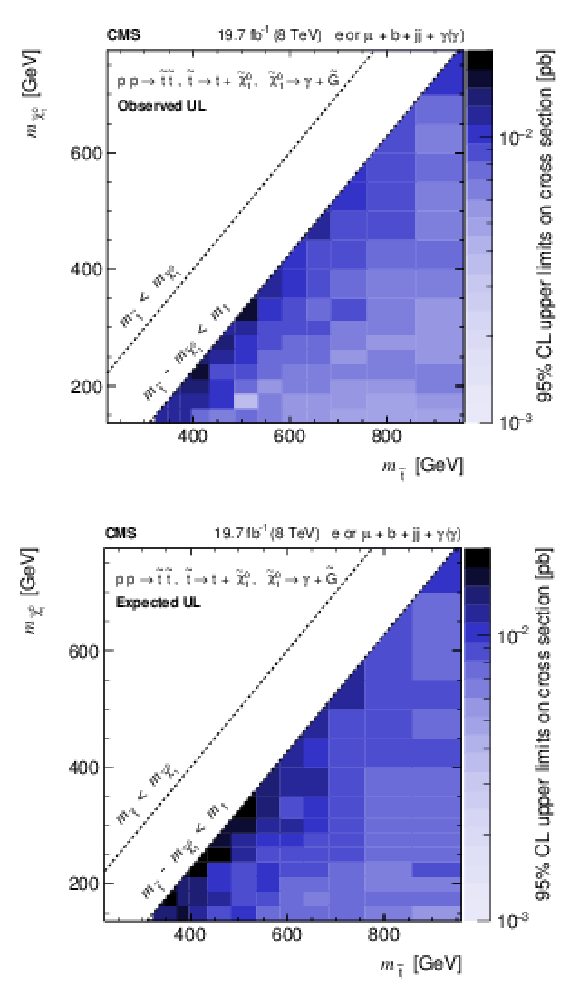
png pdf |
Figure 5:
The observed (upper pane) and expected (lower pane) CLs upper limits on the cross section at 95% CL in the $m_{\tilde{\mathrm{t}}}$-$m_{\tilde{\chi}^{0} _1}$ plane. |

png pdf |
Figure 5-a:
The observed CLs upper limits on the cross section at 95% CL in the $m_{\tilde{\mathrm{t}}}$-$m_{\tilde{\chi}^{0} _1}$ plane. |

png pdf |
Figure 5-b:
The expected CLs upper limits on the cross section at 95% CL in the $m_{\tilde{\mathrm{t}}}$-$m_{\tilde{\chi}^{0} _1}$ plane. |
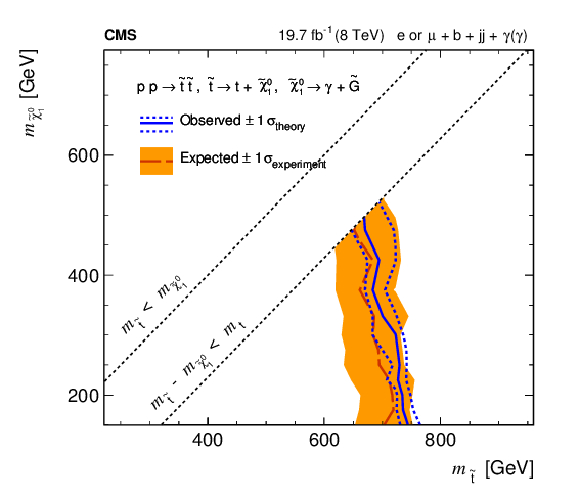
png pdf |
Figure 6:
Observed and expected mean exclusions at the 95% CL in the top squark and bino mass plane, and their ranges of uncertainties given by the contours at the 68% CL. The region to the left of the contour for $m_{\tilde{\mathrm{t}}}-m_{\tilde{\chi}^{0} _1} < m_t$ is excluded by this analysis. |
| Tables | |

png pdf |
Table 1:
Software used in MC simulations of backgrounds. |

png pdf |
Table 2:
Measured values of scale factors, $SF_{{\mathrm {Z}} (\gamma)}$ and $SF_{{\mathrm {e}}\to \gamma}$, used to correct the MC predictions for Z+jets and Z+$ {\gamma}$ backgrounds and electron-to-photon misidentification. For the electron+jets channel, the product of the two is applied to Z+jets and Z+$ {\gamma}$ backgrounds. In the muon+jets channel, only the $SF_{{\mathrm {Z}} (\gamma)}$ scale factor is relevant. The first uncertainties are statistical, obtained from uncertainties in the resultant fits. The second uncertainties correspond to differences in the resulting scale factors, added in quadrature, that were obtained by allowing each systematic uncertainty to fluctuate up and down by one standard deviation and refitting. |

png pdf |
Table 3:
Summary of systematic uncertainties: the dominant uncertainties are extracted from the control region. In the calculation of the upper limits, the normalizations of the $ {{\mathrm {t}\overline {\mathrm {t}}}} $+jets and $ {{\mathrm {t}\overline {\mathrm {t}}}} $+$ {\gamma}$ backgrounds are allowed to float freely in the fit. Check marks indicate the uncertainties that affect the shape of $ {{p_{\mathrm {T}}} ^\text {miss}} $. |

png pdf |
Table 4:
Observed data and expected background yields for the combined (e and $\mu $) signal regions. Expectations from two GGM signal model points are included, for which (460, 175) refers to $m_{\tilde{\mathrm{t}}} = $ 460 GeV and $m_{\tilde{\chi}^{0}_1} = $ 175 GeV, and similarly for (560, 325). The first group of uncertainties is statistical and the second is systematic. |
| Summary |
| We have presented a search for natural gauge-mediated supersymmetry breaking in events with a top quark pair and one or two photons. No significant deviation is found in the distribution of the missing transverse momentum between data and expected SM backgrounds that would indicate the presence of new physics. Upper limits on signal cross sections are calculated for a range of top squark and bino masses. Top squark masses between 650 to 730 GeV are excluded at the 95% CL corresponding to the neutralino mass range of 500 to 150 GeV, respectively. These top squark mass points are obtained using the $-1 \sigma$ theoretical excursion from the observed exclusion mean. These results set the most stringent exclusions on top squark masses in gauge-mediated supersymmetric model considered here. |
| References | ||||
| 1 | J. Wess and B. Zumino | Supergauge transformations in four dimensions | NPB 70 (1974) 39 | |
| 2 | Y. A. Gol'fand and E. P. Likhtman | Extension of the algebra of Poincar$ \'e $ group generators and violation of P invariance | JEPTL 13 (1971)323 | |
| 3 | D. V. Volkov and V. P. Akulov | Possible universal neutrino interaction | JEPTL 16 (1972) 438 | |
| 4 | A. H. Chamseddine, R. L. Arnowitt, and P. Nath | Locally supersymmetric grand unification | PRL 49 (1982) 970 | |
| 5 | G. L. Kane, C. F. Kolda, L. Roszkowski, and J. D. Wells | Study of constrained minimal supersymmetry | PRD 49 (1994) 6173 | hep-ph/9312272 |
| 6 | P. Fayet | Supergauge invariant extension of the Higgs mechanism and a model for the electron and its neutrino | NPB 90 (1975) 104 | |
| 7 | R. Barbieri, S. Ferrara, and C. A. Savoy | Gauge models with spontaneously broken local supersymmetry | PLB 119 (1982) 343 | |
| 8 | L. Hall, J. Lykken, and S. Weinberg | Supergravity as the messenger of supersymmetry breaking | PRD 27 (1983) 2359 | |
| 9 | P. Ramond | Dual theory for free fermions | PRD 3 (1971) 2415 | |
| 10 | G. 't Hooft | Naturalness, chiral symmetry, and spontaneous chiral symmetry breaking | NATO Sci. Ser. B 59 (1980) 135 | |
| 11 | E. Witten | Dynamical breaking of supersymmetry | Nuclear Physics B 188 (1981) 513 | |
| 12 | M. Dine, W. Fischler, and M. Srednicki | Supersymmetric technicolor | NPB 189 (1981) 575 | |
| 13 | S. Dimopoulos and S. Raby | Supercolor | NPB 192 (1981) 353 | |
| 14 | S. Dimopoulos and H. Georgi | Softly broken supersymmetry and SU(5) | NPB 193 (1981) 150 | |
| 15 | R. K. Kaul and P. Majumdar | Cancellation of quadratically divergent mass corrections in globally supersymmetric spontaneously broken gauge theories | NPB 199 (1982) 36 | |
| 16 | ATLAS Collaboration | Observation of a new particle in the search for the Standard Model Higgs boson with the ATLAS detector at the LHC | PLB 716 (2012) 1 | 1207.7214 |
| 17 | CMS Collaboration | Observation of a new boson at a mass of 125 GeV with the CMS experiment at the LHC | PLB 716 (2012) 30 | CMS-HIG-12-028 1207.7235 |
| 18 | ATLAS and CMS Collaboration | Combined measurement of the Higgs boson mass in pp collisions at $ \sqrt{s}= $ 7 and 8 TeV with the ATLAS and CMS experiments | PRL 114 (2015) 191803 | 1503.07589 |
| 19 | J. Barnard, B. Farmer, T. Ghergetta, and M. White | Natural gauge mediation with a bino next-to-lightest supersymmetric particle at the LHC | PRL 109 (2012) 241801 | 1208.6062 |
| 20 | Y. Kats, P. Meade, M. Reece, and D. Shih | The Status of GMSB After 1/fb at the LHC | JHEP 02 (2012) 115 | 1110.6444 |
| 21 | CMS Collaboration | Searches for pair production of third-generation squarks in $ \sqrt{s}= $ 13 TeV pp collisions | EPJC 77 (2017) 327 | CMS-SUS-16-008 1612.03877 |
| 22 | CMS Collaboration | Search for top squark and higgsino production using diphoton Higgs boson decays | PRL 112 (2014) 161802 | CMS-SUS-13-014 1312.3310 |
| 23 | CMS Collaboration | Search for top-squark pairs decaying into Higgs or Z bosons in pp collisions at $ \sqrt{s} = $ 8 TeV | PLB 736 (2014) 371 | CMS-SUS-13-024 1405.3886 |
| 24 | ATLAS Collaboration | Search for supersymmetry in events with photons, bottom quarks, and missing transverse momentum in proton-proton collisions at a centre-of-mass energy of 7 TeV with the ATLAS detector | PLB 719 (2013) 261 | 1211.1167 |
| 25 | ATLAS Collaboration | Search for photonic signatures of gauge-mediated supersymmetry in 8 TeV pp collisions with the ATLAS detector | PRD 92 (2015) 072001 | 1507.05493 |
| 26 | ATLAS Collaboration | Search for top squarks in final states with one isolated lepton, jets, and missing transverse momentum in $ \sqrt{s}= $ 13 TeV pp collisions with the ATLAS detector | PRD 94 (2016) 052009 | 1606.03903 |
| 27 | M. Dine and W. Fischler | A phenomenological model of particle physics based on supersymmetry | PL110 (1982) 227 | |
| 28 | C. R. Nappi and B. A. Ovrut | Supersymmetric extension of the SU(3) x SU(2) x U(1) model | PLB 113 (1982) 175 | |
| 29 | L. Alvarez-Gaum\'e, M. Claudson, and M. B. Wise | Low-energy supersymmetry | NPB 207 (1982) 96 | |
| 30 | R. Barbier et al. | $ R $-parity-violating supersymmetry | PR 420 (2005) 1 | hep-ph/0406039 |
| 31 | G. R. Farrar and P. Fayet | Phenomenology of the production, decay, and detection of new hadronic states associated with supersymmetry | PLB 76 (1978) 575 | |
| 32 | P. Meade, N. Seiberg, and D. Shih | General gauge mediation | Prog. Theor. Phys. Suppl. 177 (2009) 143 | 0801.3278 |
| 33 | M. Buican, P. Meade, N. Seiberg, and D. Shih | Exploring general gauge mediation | JHEP 03 (2009) 016 | 0812.3668 |
| 34 | S. Abel, M. J. Dolan, J. Jaeckel, and V. V. Khoze | Phenomenology of pure general gauge mediation | JHEP 12 (2009) 001 | 0910.2674 |
| 35 | J. T. Ruderman and D. Shih | General neutralino NLSPs at the early LHC | JHEP 08 (2012) 159 | 1103.6083 |
| 36 | Y. Kats and M. J. Strassler | Probing colored particles with photons, leptons, and jets | JHEP 11 (2012) 097 | 1204.1119 |
| 37 | P. Grajek, A. Mariotti, and D. Redigolo | Phenomenology of general gauge mediation in light of a 125 GeV Higgs | JHEP 07 (2013) 109 | 1303.0870 |
| 38 | CMS Collaboration | Performance of photon reconstruction and identification with the CMS detector in proton-proton collisions at $ \sqrt{s} = $ 8 TeV | JINST 10 (2015) P08010 | CMS-EGM-14-001 1502.02702 |
| 39 | CMS Collaboration | The CMS experiment at the CERN LHC | JINST 3 (2008) S08004 | CMS-00-001 |
| 40 | CMS Collaboration | Particle-flow reconstruction and global event description with the CMS Detector | JINST 12 (2017) P10003 | |
| 41 | CMS Collaboration | Commissioning of the particle-flow reconstruction in minimum-bias and jet events from pp collisions at 7 TeV | CMS-PAS-PFT-10-001 | |
| 42 | M. Cacciari, G. P. Salam, and G. Soyez | The anti-$ k_t $ jet clustering algorithm | JHEP 04 (2008) 063 | 0802.1189 |
| 43 | M. Cacciari, G. P. Salam, and G. Soyez | FastJet user manual | EPJC 72 (2012) 1896 | 1111.6097 |
| 44 | CMS Collaboration | Performance of electron reconstruction and selection with the CMS detector in proton-proton collisons at $ \sqrt(s)= $ 8 TeV | JINST 10 (2015) 1748 | |
| 45 | CMS Collaboration | Performance of CMS muon reconstruction in pp collision events at $ \sqrt{s}= $ 7 TeV | JINST 7 (2012) P10002 | CMS-MUO-10-004 1206.4071 |
| 46 | CMS Collaboration | Identification of b-quarks jets with the CMS experiment | CMS-PAS-BTV-15-001 | CMS-PAS-BTV-15-001 |
| 47 | CMS Collaboration | Performance of b tagging at sqrt(s)=8 TeV in multijet, ttbar and boosted topology events | CMS-PAS-BTV-13-001 | CMS-PAS-BTV-13-001 |
| 48 | J. Alwall et al. | MadGraph 5: going beyond | JHEP 06 (2011) 128 | 1106.0522 |
| 49 | T. Sjostrand, S. Mrenna, and P. Z. Skands | PYTHIA 6.4 physics and manual | JHEP 05 (2006) 026 | hep-ph/0603175 |
| 50 | S. Frixione, P. Nason, and C. Oleari | Matching NLO QCD computations with parton shower simulations: the POWHEG method | JHEP 11 (2007) 070 | 0709.2092 |
| 51 | Z. Was | TAUOLA the library for tau lepton decayand KKMC/KORALB/KORALZ/... status report | NPPS 98 (2001) 96 | hep-ph/0011305 |
| 52 | CMS Collaboration | Study of the underlying event at forward rapidity in pp collisions at $ \sqrt{s} = $ 0.9 , 2.76, and 7 TeV | JHEP 04 (2013) 072 | |
| 53 | CMS Collaboration | Event generator tunes obtained from underlying event and multiparton scattering measurements | EPJC 76 (2016) 155 | |
| 54 | GEANT4 Collaboration | GEANT4---a simulation toolkit | NIMA 506 (2003) 250 | |
| 55 | J. Pumplin et al. | New generation of parton distributions with uncertainties from global QCD analysis | JHEP 07 (2002) 012 | hep-ph/0201195 |
| 56 | N. Smirnov | Table for estimating the goodness of fit of empirical distributions | Ann. Math. Statist. 19 (06, 1948) 279 | |
| 57 | S. Abdullin et al. | The Fast Simulation of the CMS detector at LHC | in Int'l Conf. on Computing in High Energy Physics (CHEP 2010) Taipei, Taiwan, October, 2010 Journal of Physics: Conference Series 331 (2011) 032049 | |
| 58 | A. Djouadi, J.-L. Kneur, and G. Moultaka | SuSpect: A Fortran code for the supersymmetric and Higgs particle spectrum in the MSSM | CPC 176 (2007) 426 | hep-ph/0211331 |
| 59 | M. Muhlleitner, A. Djouadi, and Y. Mambrini | SDECAY: A Fortran code for the decays of the supersymmetric particles in the MSSM | Comput. Phys. Comm. 168 (2005) 46 | |
| 60 | W. Beenakker, R. Hopker, and M. Spira | PROSPINO: A Program for the production of supersymmetric particles in next-to-leading order QCD | hep-ph/9611232 | |
| 61 | B. C. Allanach et al. | SUSY Les Houches Accord 2 | CPC 180 (2009) 8 | 0801.0045 |
| 62 | T. Junk | Confidence level computation for combining searches with small statistics | Nucl. Inst. Meth. A 434 (1999) 435 | hep-ex/9902226 |
| 63 | A. L. Read | Presentation of search results: the $ CL_s $ technique | JPG 28 (2002) 2693 | |
| 64 | G. Cowan, K. Cramer, E. Gross, O. Vitells | Asymtotic formulae for likelihood-based tests of new physics | EPJC 71 (2011) 1554 | 1007.1727v3 |
| 65 | R. Barlow and C. Beeston | Fitting using the Monte Carlo samples | Comput. Phys. Comm. 77 (1993) 219 | |

|
Compact Muon Solenoid LHC, CERN |

|

|

|

|

|

|